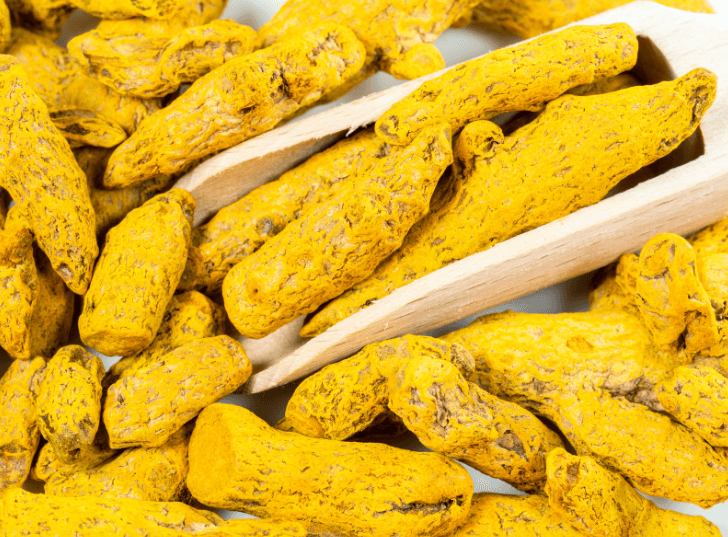Turmeric root is the underground rhizome of the turmeric plant, scientifically known as Curcuma longa. It is a bright orange-yellow and is commonly used as a spice in cooking, particularly in Indian and Southeast Asian cuisines.
Turmeric root has a warm, bitter taste and is often used to give dishes a vibrant color and flavor.
In this article, we will discuss some tips on using turmeric root for the 45+ age group.
What is Turmeric Root?
Turmeric root, technically known as Curcuma longa, is a flowering plant from the ginger family Zingiberaceae. Turmeric is native to Southeast Asia, including India and Indonesia, and has been grown for thousands of years for culinary and medicinal uses.
To produce the vivid yellow powder known as turmeric, the turmeric plant’s rhizomes, or subterranean stems, are picked, cleaned, cooked, dried, and pulverized.
Health Benefits of Fresh Turmeric Root
Turmeric root has been used in traditional medicine for centuries, and the current study is looking at its potential benefits in a variety of health concerns. Here are some of turmeric root’s benefits:
Inflammation
Chronic inflammation is connected to a variety of health issues. According to research, curcumin may have anti-inflammatory qualities that might help control pain and inflammation linked with arthritis, inflammatory bowel disease (IBD), and other illnesses.
Oxidative Stress
Free radicals, unstable chemicals created by the body and the environment, can harm cells. Curcumin’s antioxidant capabilities may assist counteract oxidative stress and may lower the risk of chronic illnesses
Cognitive Health
Age-related cognitive decline and neurodegenerative disorders such as Alzheimer’s are serious issues. Some studies indicate that curcumin may help to protect brain function and memory [8]. However, further study is required to establish these impacts.
Digestive Health
Curcumin may improve gut health by encouraging healthy gut flora and lowering inflammation in the digestive system
Cardiovascular Health
Early research shows that curcumin may enhance blood vessel function and perhaps lower the risk of heart disease. However, bigger investigations are required to corroborate these results.
How To Use Turmeric Root
Tip 1: Add Turmeric to Your Diet
The easiest way to incorporate turmeric into your daily routine is by adding it to your diet. Turmeric can be used in various dishes, such as curries, soups, and stews. It can also be added to smoothies, juices, and tea.
Turmeric has a warm and slightly bitter taste, which can complement the flavors of many foods. Adding turmeric to your diet can help improve your digestion, reduce inflammation, and boost your immune system.
Tip 2: Use Turmeric as a Natural Pain Reliever
As people age, they may experience various types of pain, such as joint pain, arthritis, and muscle soreness. Turmeric can be used as a natural pain reliever due to its anti-inflammatory properties.
Curcumin, the active compound in turmeric, can help reduce inflammation in the body, which can alleviate pain. Turmeric can be used topically or ingested to help relieve pain.
For topical use, turmeric can be mixed with coconut oil or other carrier oils and applied to the affected area. For internal use, turmeric can be added to food or taken as a supplement.
Tip 3: Use Turmeric for Brain Health
As people age, their cognitive function may decline, leading to memory loss and other cognitive impairments.
Turmeric can be used to help improve brain health and cognitive function. Curcumin, the active compound in turmeric, can help increase the production of brain-derived neurotrophic factor (BDNF), which is a protein that promotes the growth and survival of brain cells.
Turmeric can also help reduce oxidative stress and inflammation in the brain, which can contribute to cognitive decline. Turmeric can be added to food or taken as a supplement to help improve brain health.
Tip 4: Use Turmeric for Heart Health
Heart disease is one of the leading causes of death among people over 45 years of age. Turmeric can be used to help improve heart health and reduce the risk of heart disease. Curcumin, the active compound in turmeric, can help reduce inflammation and oxidative stress, which are both risk factors for heart disease. Turmeric can also help improve the function of the endothelium, which is the lining of the blood vessels. Turmeric can be added to food or taken as a supplement to help improve heart health.
Tip 5: Use Turmeric for Skin Health
As people age, their skin may become dull, dry, and wrinkled. Turmeric can be used to help improve skin health and reduce the signs of aging. Curcumin, the active compound in turmeric, can help reduce inflammation and oxidative stress in the skin, which can contribute to aging.
Turmeric can also help improve collagen production, which is essential for maintaining skin elasticity and firmness. Turmeric can be used topically or ingested to help improve skin health.
Tip 6: Use Turmeric for Digestive Health
As people age, their digestive system may become less efficient, leading to various digestive issues such as bloating, gas, and constipation. Turmeric can be used to help improve digestive health and alleviate digestive issues.
Turmeric can help stimulate the production of digestive enzymes, which can improve digestion and nutrient absorption. Turmeric can also help reduce inflammation in the gut, which can contribute to digestive issues. Turmeric can be added to food or taken as a supplement to help improve digestive health.
Turmeric Recipes
Adding turmeric root to food is simple and adds taste and color to your meals. Here are a few tasty turmeric dishes to try:
- Turmeric roasted vegetables: Combine sliced carrots, sweet potatoes, and cauliflower with olive oil, turmeric, cumin, and garlic powder. Roast in the oven until soft and golden brown.
- Turmeric lentil soup: Cook lentils, onions, garlic, carrots, celery, turmeric, cumin, and vegetable broth until soft. Blend until smooth and creamy for a filling and healthy soup.
- Turmeric chicken curry: To make turmeric chicken curry, sauté chopped chicken breast with onions, garlic, ginger, turmeric, cumin, coriander, and coconut milk. Simmer until the chicken is cooked through, then serve with rice or naan bread.
- Turmeric smoothie: For a refreshing and antioxidant-rich smoothie, combine fresh turmeric root, pineapple, mango, banana, spinach, coconut milk, and a sprinkle of black pepper.
Conclusion
Turmeric is a versatile spice that can be used in various ways to improve the health and well-being of people over 45 years of age. Turmeric can be added to food or taken as a supplement to help improve brain health, heart health, skin health, and digestive health and alleviate pain.
When using turmeric, it is important to start with a small amount and gradually increase the dosage to avoid any adverse effects. As with any supplement or medication, it is essential to consult with a healthcare professional before adding turmeric to your daily routine.
If you enjoyed this article, you may also want to read this article on 10 Effective Strategies to Lose 50 Pounds in a Month.
*This information is not intended to serve as a substitute for professional medical or dietary advice tailored to individual needs.
Dr. Kimberly Langdon has been an MD for 31 years, board-certified obstetrician/gynecologist with 19-years of clinical experience. She graduated from The Ohio State University College of Medicine, earning Honors in many rotations. She then completed her OB/GYN residency program at The Ohio State University Medical Center, earning first-place accolades for her Senior Research Project and Score of 98th percentile on a National Proficiency Test.
During her clinical career, she delivered over 2000 babies and specialized in minimally invasive procedures, menopause, endometriosis, menstrual disorders, and polycystic ovarian syndrome. After retiring from clinical practice, she founded a medical device company to commercialize her two patented and four patent-pending medical devices for both life-threatening and non-life-threatening infections.




